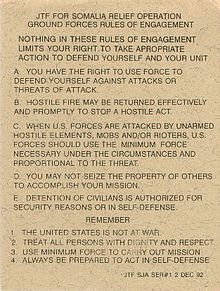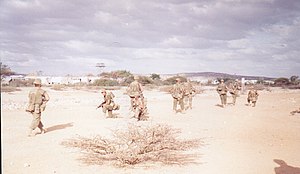United Nations Operation in Somalia I
| UNOSOM I | |
|---|---|
| operation area | Somalia |
| German name | United Nations Operation in Somalia I. |
| English name | United Nations Operation in Somalia I |
| French name | Opération des Nations Unies en Somalie I |
| Based on UN resolution | 751 (April 24 1992) |
| Other UN resolutions | 775 (August 28, 1992) |
| Type of mission | Peace mission |
| Beginning | April 1992 |
| The End | March 1993 |
| management |
Mohamed Sahnoun ( Algeria ) April 1992 – November 1992 Ismat Kittani ( Iraq ) November 1992 – March 1993 Jonathan T. Howe ( USA ) March 1993 – then UNOSOM II |
| Deaths | 6th |
| costs | US $ 42.9 million (net) |
| Location of the operational area |

|

The United Nations Operation in Somalia I ( UNOSOM I , German Operation of the United Nations in Somalia I ), a UN peacekeeping mission , was based on UN resolution 751 of April 24, 1992 and took place from April 1992 to March 1993. The mission was initially called UNOSOM before it was replaced by UNOSOM II . The aim of this humanitarian intervention was to secure the delivery of food aid to those affected by civil war and famine .
background
After the overthrow of the authoritarian government under Siad Barre , civil war broke out in Somalia , which continues to this day. From November 1991, heavy fighting broke out in the capital Mogadishu between armed groups led by General Mohammed Farah Aidid , Ali Mahdi Mohammed and other parties. In addition, there was a conflict in Kismayo while local leaders declared Somaliland's independence in the northwest of the country . Looting, banditry and violence between the various fighting clans and with and among the civilian population were widespread.
These struggles between warlords, clans, and sub-clans in loose alliances coincided with a severe drought. This combination led to the famine in Somalia , as a result of which nearly 4.5 million people - more than half the population - were at risk of starvation and disease. In total, it is estimated that 300,000 people, including many children, died. Around 2 million Somalis fled either to neighboring countries, particularly Kenya , or as internally displaced persons in various regions of the country.
UN resolutions
Against this background, on January 23, 1992, the UN Security Council unanimously passed UN Resolution 733 under Chapter VII of the UN Charter and imposed a general and complete arms embargo on Somalia. On March 17, 1992, the Security Council unanimously adopted UN Resolution 746 , which contained the urgency of continuing humanitarian work in Somalia. She also supported the decision of Secretary General Boutros Boutros-Ghali to deploy a technical response team. The UN Resolution 751 authorized the UN as of 24 April 1992 50 military observers and 500 UN peacekeepers in the country to send. On August 28, 1992, UN Resolution 775 followed , which made it possible to increase the total number of technical, humanitarian and military personnel.
Mission dates
The mission's headquarters were in Mogadishu. The team consisted of 50 military observers, 3,500 security forces, up to 719 logistical support personnel and around 200 international civilian employees. The cost of the mission was $ 42,931,700.
Function of the mission
The mission was used to oversee a ceasefire between warlords Mohammed Farah Aidid and Ali Mahdi Mohammed in Mogadishu and to provide protection and security for UN personnel, equipment and supplies at the seaports and airports in Mogadishu. This included the escorted deliveries of humanitarian supplies from there to the distribution centers in and around the city. In August 1992, the Mission's authority and strength were increased to enable it to protect humanitarian convoys and distribution centers across Somalia.
In December 1992, after the situation in Somalia had deteriorated further, the Security Council authorized member states to set up the so-called Unified Task Force UNITAF - two-thirds of which consisted of US troops and were under their command - to deliver humanitarian aid to back up. UNITAF worked in coordination with UNOSOM I to secure the population centers and ensure that humanitarian aid could be given and distributed.
The mandate passed to the UNOSOM II mission in March 1993 after UN resolution 814 (1993) was passed .
literature
- Weber, Mathias: The UN mission in Somalia - The problem of a humanitarian intervention , Denzlingen 1997, ISBN 3-9805387-0-2 .
- Rittberger, Volker; Mogler, Martin; Zangl, Bernhard: United Nations and World Order - Civilizing International Politics? , Leske + Budrich, Opladen 1997.
Web links
- Website UNOSOM 1 (English)

